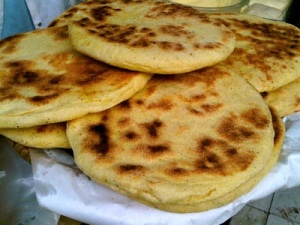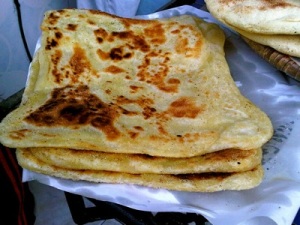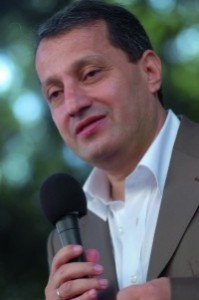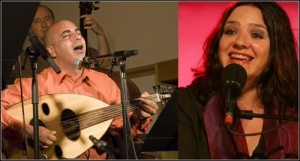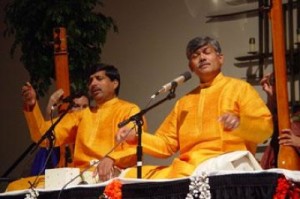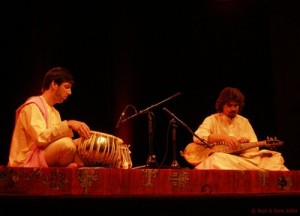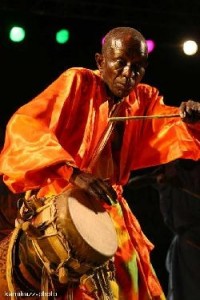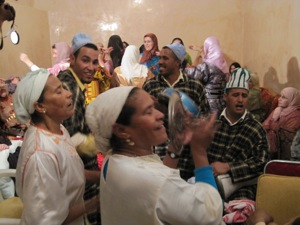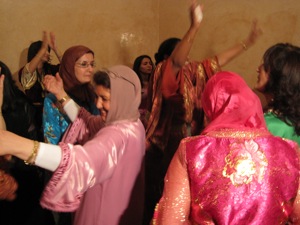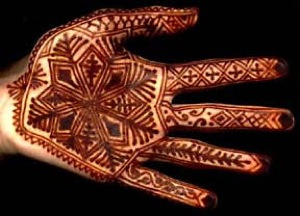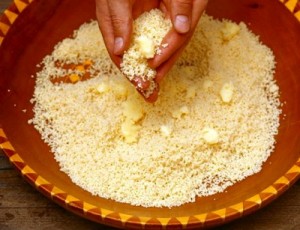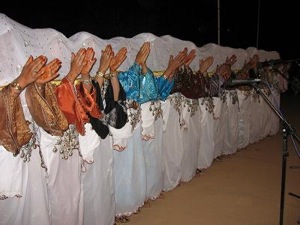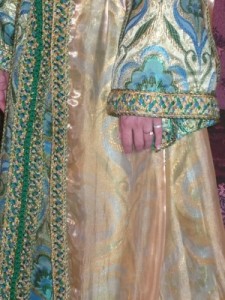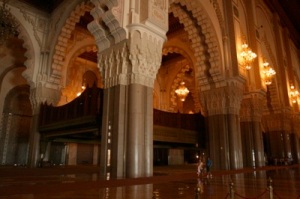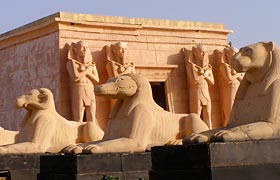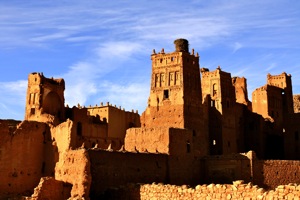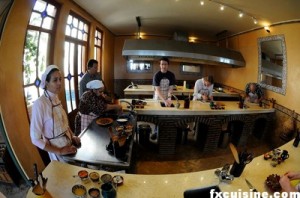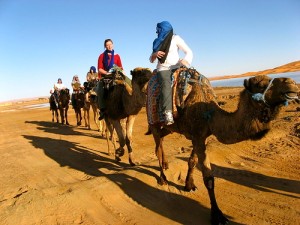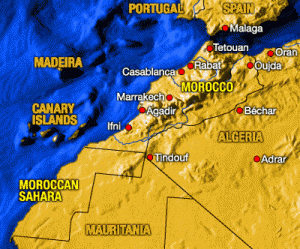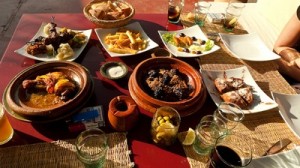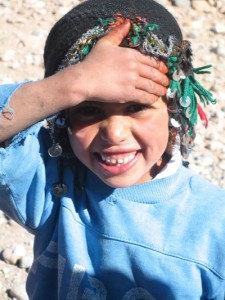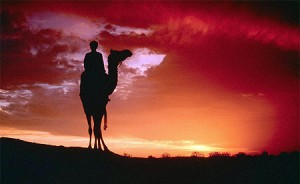
Fes Festival Musician
Travel Exploration & Authentic Asia Present The Fes Festival of World Sacred Music & Morocco Cultural Tour – Hosted by Music Expert, Joel Davis
This 13 Day/ 12 Night Morocco Fes Music Festival Tour will offer a celebratory opportunity for those who are passionate about Sacred World Music to enrich their palate with a variety of international sounds ranging from Andalusian Classical music to African, Asian, Moroccan Sufi and more while taking a journey across Morocco’s Imperial Cities, Majestic Landscapes, the Sahara Desert and Valley’s. This all inclusive 13 Day/12 Night Morocco Private group tour guarantees combined 4/5 Star accommodations at charming Riads and luxury Moroccan hotels and properties, private transport, historical guides, museum and monument entrance fees along with tickets to the Fes Festival of Sacred World Music. Don’t miss out on this special opportunity to travel to Fes, Morocco and other regions such as Marrakech, Ouarzazate and the Sahara Desert with a music guide and historical guides who will bring depth and understanding to the meaning of Morocco’s music and vast cultural traditions.

View of Fes El Bali, Old Medina & UNESCO World Heritage Site
Fes is a UNESCO World Heritage site and the oldest world medina (old city) in the world. Come join our private group and participate in seeing renowned musicians from all over the world gather in Fes — Morocco’s spiritual capital. Travel Exploration’s private tour package includes a music guide, historical guides, daily sight-seeing tours in air-conditioned luxury minibuses or 4×4 land cruiser with multi-lingual speaking drivers that are fluent in English, Arabic, French and Berber. Also included are tickets to the Fes Festival performances in Morocco’s holy city of Fes. For more information on the 17th Edition of the Fes Festival World Sacred Music program.

Fes Festival Whirling Dervishes
Artists from around the world flock to Morocco’s spiritual capital during the annual Fez Sacred Music Festival. The top music artists from Middle Eastern and Western religious communities gather in Fez for a week of concerts, lectures, exhibitions, and intellectual and artistic exchanges. Performances have included the Sufi Whirling Dervishes of Turkey, Berber trance music, Arab-Andalusian music, Hindustani chants, Celtic sacred music, Christian Gospel, flamenco, and the Philharmonic Orchestra of Morocco, with French classical musicians always proving popular. There has also been Sufi artists from India and Pakistan, Japanese drumming bands and a group of vocalists from Mali.

The Ablution Room in the Hassan II Mosque in Casablanca
DAY 1: CASABLANCA ARRIVAL – RABAT- FES
►Arrival at Casablanca International Airport.
►Have breakfast upon arrival, then visit the Mosque of Hassan II. Casablanca is home to the Hassan II Mosque, designed by the French architect Michel Pinseau. It is situated on a promontory looking out to the Atlantic, which can be seen through a gigantic glass floor with room for 25,000 worshippers.Its minaret is the world’s tallest at 210 meters. It is an enormous architectural masterpiece and the second largest religious building in the world. On Fridays, the Mosque of Hassan II is open to non-Muslims.The Mosque of Hassan II’s promontory offers lovely views overlooking Casa in the residential Afna quarter.
►After visiting the Hassan II Mosque, take the road to Rabat for a half-day tour of this Imperial City.
►During your half-day tour you will learn Rabat’s history and enjoy its beautiful domes, minarets, wide avenues and green spaces. Your guide will escort you on a walk around the picturesque Almohad northern walls of the Oudaïa Kasbah. The kasbah was built by Moulay Ismaïl from 1672-1727 to protect the city and is enclosed by ramparts dating from the Almohad period. Visit Bab Oudaïa, a monumental gate and example of Almohad military architecture. See the Musée de Oudaïa, Moulay Ismaïl’s palace exhibiting collections of Moroccan folk art. Before moving on to city medina, relax in the Moorish style Andalusian garden.
►Visit the Royal Palace, the Hassan Tower which stands on the hill overlooking the Wadi Bou Regreg. It is a gigantic mosque, emblematic of Rabat and famous for its unfinished minaret where storks nest.
►Next door, visit the beautiful Mausoleum of Mohammed V decorated with stained glass windows, white marbleand a wrought-iron entryway with a stairway leading to an impressive dome.
►Lunch in Rabat, by the Sea.
►Explore the gardens nearby and visit the Palace of Rabat and visit the Necropolis at Chellah/ Kasbah of Chellah.
►Dinner & Spend the night at a 4 Star Charming Riad or Hotel in Fes.
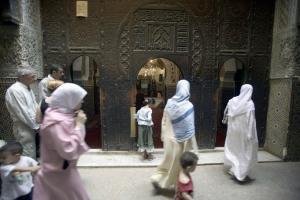
Moulay Idriss Mosque Fes
DAY 2: FES (GUIDED HISTORICAL TOUR)
►After breakfast your day will begin at the Merenid Tombs of Fès.
►Next, stop at the Musée des Armes, a fortress that once protected Fès. Today it is possible to see a display of 8,000 pieces of artillery from Makina, the arsenal built by Moulay Hassan I.
►Enter the Fès el- Bali through the symmetrical horse shoe arches at Bab Boujeloud (The Blue Gate). Fès -el Bali, best characterized as a sea of rooftops embellished with minarets and domes, is too narrow for cars. Aside from walking, donkeys and mules are still the best way to travel within the cities old walls.
►Upon entering Rue Talaa Kebira, the main street in the medina, you will see lines of shops covered by canopies. Make your way to the Karaouiyine Mosque. Located in the Karaouiyine quarter, the Mosque is one of the oldest in the world and functioned as the first university in Morocco. After your visit, continue along the streets which will lead you to some of Fes’ most important buildings including Dar el- Magana, a fourteenth century water clock and Zaouia el Tijaniya, containing the tomb of Ahmed el Tijani, who spread his infamous doctrine Tariqq el- Tijaniya (The Way) throughout Morocco.
►We will also stop to visit the Ech Cherabliyine Mosque (Mosque of the Slipper makers) then browse the souks selling henna, slippers, caftans, silks, jewelry and spices.
►Next onto the UNESCO recognized site, Fondouk el- Najjarine. Within the foundouk’s three floors is the Musée de Bois, which displays carved doors from the Bou Inania Medersa.
►Stop for lunch within the medina at one of the fine Moroccan palace-restaurants that serves an extravaganza of mezas for lunch.
►After lunch we will visit the Musée Dar el- Batha to view the great collection of pottery, leather-work, wood, books and manuscripts from the nineteenth century.
►Next, enter Bab el Ftouh, the “Gateway of the Aperture” to explore the Andalusian quarter, a residential part of the medina laced with monuments. Our last part of the tour will take you into the Fès el Jedid, a kasbah which functioned as Morocco’s administrative center until 1912. Explore the royal palace and many interesting quarters including the Moulay Abdalllah Quarter, the Mellah (Jewish Quarter) and a little farther down south lies Ville Nouvelle (The New Quarter).
Within the Fes medina, we will the following historical sites:
►Medersa Bou Inania: An (Islamic school) founded by Abu Inan Faris that is highly decorated from floor to ceiling. The medersa is one of the few religious places in Morocco that is accessible to non-Islamic tourists.
►Kairaouine Mosque: Morocco’s second largest mosque was built by Fatima in 857. The Kairaouine Mosque became the home of the West’s first university and the world’s foremost center of learning at the beginning of the second millennium.
►University of Al-Karaouine: Founded in 859, this university is one of the leading spiritual and educational centers of the Muslim world and is considered the oldest continuously operating institution of higher learning in the world.
►Zaouia Moulay Idriss II: A zaouia (shrine) dedicated to and the tomb of Moulay Idriss II, who ruled Morocco from 807 to 828 and founded the city of Fès for the second time in 810.
►Dar Batha: A Hispano-Moorish palace dating from the end of the 19th century that houses admirable collections of traditional art from Fès.
▶Weavers Cooperative: We will also visit the Weavers Cooperative located in a residential neighborhood off a main shopping street. The workshop specializes in weaving the finest jellaba fabric, made of silk and wool threads imported from Italy. The shop also makes a quality jellaba fabric from locally spun, textured wool thread called hubba -sometimes referred to as couscous, because it’s nubby texture resembles Morocco’s national semolina dish of the same name.
▶Tanneries: The Chourara or the Tanner’s Quarters is the most lively and picturesque souks in Fès. The Tanneries are often located near watercourses like the Wadi Fès and at a distance from residential areas due to the strongly unpleasant smells they produce.
▶Carpet Demonstration: Antique and Modern Carpets is one of the places in Fès el Bali where you can see a Berber carpet demonstration. You will be offered mint tea and follow your guide up a coil of stairs to a small area to watch carpets being made by young girls who come from the mountains to show tourists how Berber carpets are made.
▶Dyers Market: The dyers market, located along Rue de Teinturies, is the best place to see the dying vats which have been used for centuries to soak the skins of sheep, goat, cows and camels after they have their hair and flesh removed is best seen from the neighboring terraces. You will see many tanned hides colored with natural pigments ranging from shades of brown, black, turquoise fuchsia, yellow and orange.
▶Potter’s Cooperative: You will also visit the Potter’s Cooperative. Also known as Place el-Seffarine, this kisseria is the most important center for the production Fasiss style ceramics, brass-ware and silverware in Morocco.
►Welcome Dinner at Le Maison Bleue, an exotic and fine Fasis restaurant in the Old Medina with a quaint show of Gnaoua Music as you dine.
►First night- showcase of the Fes Festival of Sacred Music’s sites and sounds at the Bab Makina in Fes.
►Spend the night at a 4 Star Charming Riad or Hotel in Fes.
DAY 3: FES – MEKNES – VOLUBILIS
►Breakfast at your Hotel in Fes. Then take the road to Meknes.
►Arrive in Meknes. Begin your visit at the 18th Century Palace built by Sultan Mohammed Ben Abdallah.
►Then pass through the triumphal arch. Standing at sixteen meters high with an eight meter long arch, the intricately patterned triumphal arch is argued to be the most beautiful in Morocco. Enter Place El-Hedime (Square of Ruins) which links the medina and the kasbah. The square is lined with modern residential buildings and a covered food souk (market).
►We will stop and visit the Musée Dar Jamaï, a museum showing modern Moroccan arts, woodwork, ceramics, carpets, costumes, jewelryand metalwork. The sophisticated building was once a palace incorporating a mosque, menzah (pavilion), courtyard, kitchen and hammam.
►Next we will visit the Bou Inania Medersa to explore the beautiful Koranic school established by the Merinids in the 14th century. Opposite of the Medersa, see the Grand Mosque.
►Among the most impressive elements of this imperial city is the grand gate named after the architect, El-Mansour, a Christian renegade who converted to Islam. The design of the gate plays with Almohad patterns. It has zellij mosaics of excellent quality. The marble columns were taken from the Roman ruins of Volubilis.
►Lunch in Meknes.
►After visiting Meknes, take the road to explore the breathtaking archaeological site of Volubilis (Walili). Once occupied by the Romans, Volubilis has been recognized by UNESCO as a world heritage site and gained international acclaim when Martin Scorsese made it a feature location for his film, The Last Temptation of Christ.
►Begin your visit by discovering the fascinating Roman ruins adorned with beautiful mosaics and colorful tiles depicting Roman mythology. The ruins are spread out across several acres and what remains visible is several fragments of wall, parts of massive columns, the capitol, the basilica and a triumphal arch. The ruins reveal how the Roman Empire transformed the original Carthaginian settlement into a typical Roman city complete with mansions, a town center, a triumphal arc and temples devoted to the Roman gods.
►Enjoy tea at the small café that sits just below the Volubilis ruins. Next explore the open-air museum with remains of altars, sculptural fragments and colorful mosaics.
►Commence your visit in Volubilis, then take the road to Fes. Arrrive in the evening.
►Second night- showcase of the Fes Festival of Sacred Music’s sites and sounds at the Bab Makina in Fes.
►Spend the night at a 4 Star Charming Riad or Hotel in Fes.

Fes Batha Museum
DAY 4: FES (FASIS POTTERY COOPERATIVE, SIDI HARAZEM SPA & FREE EXPLORATION)
►Rise, have breakfast at your Riad, then stroll the Jnan S’bil Garden, a popular botanical garden in Fes where locals frequent for morning and afternoon walks, to read a book or relax. Jnan S’bil Garden has been closed for several years for a reservation and it is re-opening spring 2010.
►Next, visit Fes’ renown Pottery Cooperative where you can view how the Fasis pottery and zellij tile are made by hand. Tour the cooperative to see how the various artisans work using the ancient Fasis techniques that are unique to this Imperial city and region. Participate if you wish by throwing a pot or starting to make your own zellij tile. See the works of the artisans which are available for purchase as well.
►After visiting the Fasis Pottery Cooperative enjoy the rest of the afternoon visiting other sites on your own or exploring the old Fes medina cobble stoned streets or consider a visit to a Spa just outside of Fes.
►Fes, is believed to be the world’s largest contiguous car-free urban area and you will be able to roam free, only having to move aside for the donkeys that will need to pass bringing goods across from place to place.
►If roaming around Fes on your own is not of interest, then take the road to visit Sidi Harazem, a Spa and green area just outside of Fes which contains hot water springs that are rich in magnesium. The benefits of these curative waters may be enjoyed at the health spa.There is also an ancient sacred pool surrounded by eucalyptus, palm and pink laurel trees.
►The other option is to visit Moulay Yacoub an old French, style Spa with thermal stations, cold dipping pool along with rock hot saunas and steam rooms. Compliment your visit with an old world, French- Moroccan massage with rose, orange or jasmine oil, receiving a treatment from head to toe.
►Dinner options are at your Riad, in the Ville Nouvelle (new city), Le Palais D’Medina or Le Maison Bleue.
►Third night- showcase of the Fes Festival of Sacred Music’s sites and sounds at the Bab Makina in Fes.
►Spend the night at a 4 Star Charming Riad or Hotel in Fes.
DAY 5: FES – ZIZ VALLEY – IFRANE- MERZOUGA
►Rise, have breakfast at your Riad. Then take the road to Merzouga. Enroute to Merzouga, we will pass Ifrane, stopping to see the cedar tree forrest and the local barbary monkeys. We will also pass the American- Moroccan University which was built by the Saudi’s.
▶ We will have lunch during our journey in the Ziz Valley or at another local town en route to the Sahara desert. We will continue the road to Merzouga and arrive before sunset.
▶Arrive in Merzouga before sunset, then go by dromedary camel for 45 minutes- one-hour, at sunset into the Erg Chebbi Dunes to camp overnight luxury Biouvac tent at an oasis. Your Tuareg guide will share some of the Sahara Deserts’ secrets. As you glide across humpback on these silent, mystical dunes there will be countless opportunities to photograph the endless rolling dunes.
▶Dinner & Spend the night at a Charming Bivouac near an Oasis within the Erg Chebbi Dunes of Merzouga’s Sahara Desert with traditional Entertainment in a Majestic 1001 Nights Tent.– Guest House Option Available For Those Who Prefer.
DAY 6: MERZOUGA – RISSANI- ERFOUD -N’KOB -OUARZAZATE
▶Rise, have breakfast and take a sunrise trek back to Merzouga center. Enjoy the flora and fauna that is unique to the Sahara. Then take the road to visit the Saharan Desert towns of Rissani and the capital of fossils, Erfoud. Visit the old ksars and then continue the road to the village of Ait Ouzzine, located in N’kob which is nestled within the Middle Atlas Mountains.
►Aït Ouzzine is a Berber village inhabited by over 300 families who live in beautifully painted crenulated kasbahs, with their own henna fields, water wells, livestock and gardens. This peaceful village is tucked away along an impressive desert route connecting the Draa Valley (Tansikht) and Rissani.
►Lunch will be served to you in Aït Ouzzine by a traditional Berber, Moroccan family. The menu will include a traditional meal of fresh baked bread with spices and a chicken and vegetable tajine and fresh local fruits for desert. After lunch, you can have your hands and feet painted with henna or your hair adorned with saffron by a local village artist and relax. Experience the tradition of Berber perfume made from musk and amber along with the villages own spices.
►End the afternoon in Ait Ouzzine with mint tea and almonds. Take the through the Draa Valley back to Ouarzazate before sunset.
►The Draa Valley is the road of the old caravans that were once traveled to transport dates and other good from the Draa Region to Marrakech. Arrive and have dinner at your Riad.
►Dinner & Spend the night at a 4 Star Charming Riad or Hotel in Ouarzazate.
DAY 7: OUARZAZATE ANCIENT KASBAHS
►Breakfast at your Riad. “See Ouarzazate and die” are feelings often expressed by Moroccans with regards to this magical city that is the door to the Sahara desert. Located just four hours from Marrakesh, Ouarzazate is the main Berber city in the south known for its spectacular sunsets and dramatic mountain and desert scenery. Surrounded by breathtaking valleys, Ouarzazate was once crossing point for African traders seeking to reach northern cities in Morocco and Europe. During the French period, Ouarzazate expanded considerably as a garrison town and became the administrative centre of the Zagora region. Ouarzazate became famous when it’s nearby Kasbah; Ait Benhaddou in the 1962 film Lawrence of Arabia.
► Visit the Oasis of Fint, the Atlas Film Studios, Aït Benhaddou & Kasbah Taouirt.
► Take the road to the Oasis of Fint that hovers under the Atlas Mountains. Journey on a one-hour walk inside the Oasis where you will have a cup of tea with the headmasters family Azziz Ouaziz and tour the surrounding area where date palm oases and dramatic desert scenery are king.
► After visiting the Oasis of Fint we will take the road to the Atas Film Studios. David Lean filmed Lawrence of Arabia at The Atlas Film Studios in the early 1960’s. Since then many famous directors have followed in his footsteps to exploit the magnificent scenery. International blockbusters shot here in recent years include: the French version of Cleopatra, Bertolucci’s Sheltering Sky, Scorsese’s Kundun, Gillies MacKannon’s Hideous Kinky, Ridley Scott’s Gladiator, Black Hawke Down, Oliver Stone’s Alexander The Great, Ridley Scott’s Kingdom of Heaven, and Penelope Cruz’s Sahara.
► Next visit Aït Benhaddou. Aït Benhaddou is located 32 km from Ouarzazate lies the picturesque village. Aït Benhaddou of Aït Benhaddou is situated in Souss-Massa-Draâ on a hill along the Ouarzazate River. Lawrence of Arabia was filmed here and Orson Welles used it as a location for Sodome and Gomorrah; and for Jesus of Nazareth the whole lower part of the village was rebuilt. In recent years more controlled restoration has been carried out under UNESCO auspices. Aït Benhaddou is one of many locations in this region used for shooting Hollywood films. This Berber village of towered and crenulated Kasbahs that once guarded the lucrative caravan route through the Atlas Mountains.
►Lunch on a terrace with clear views of Aït Benhaddou and enjoy a traditional Moroccan or Moroccan salada and a hearty tajine.
► End the day with a short visit to Kasbah Taouirt which was was built by the Pasha Glaoui. Kasbah Taouirt’s location was strategic for trading routes and in the 1930’s when the Glaoui ruled the South it was then one of Morocco’s largest Kasbahs. Explore its nooks and crannies and discover some local female painters who sell their art inside as well as the many quality silver shops just steps outside the Kasbah.
►Dinner & Spend the night at a 4 Star Charming Riad or Hotel in Ouarzazate.
DAY 8: OUARZAZATE – BOUTHGRAR (VALLEY OF NOMADS), VALLEY OF ROSES, BOUMALNE DADES VALLEY & GORGE – SKOURA
►Breakfast at your Riad. Take the road to visit Bouthgrar, the Valley of Nomads and the Dades Valley.
►Begin your visit at the breakthtaking Valley of Nomads. Located in Bouthgrar is the Valley of Nomads, a beautiful 10 kilometer valley where Nomads live in caves that are surrounded by Mount Mgoun. Mount Mgoun is the second highest mountain in Morocco and boasts extraordinery views. Have tea with a Nomad family. See first hand where they make their own carpets and co exist in Bouthgrar with other Nomad families.
►Your journey will then take you through the Dadès Valley which covers 125 km between Ouarzazate and Boumalne du Dadès in the High Atlas Mountains.
►Once you reach Boumalne at first sight you notice the limestone cliffs with uniquely shaped erosions and superb scenery and the valley’s pise (windy roads). Driving along you will pass flower filled fields, fertile fields, riverbanks and several fortified ksours. At the bottom of Gorge of Boumalne Dadès there are ruined hilltop Kasbahs and valley floor gardens.
►Lunch will be served at a nearby guesthouse that offers local Moroccan fare and a panoramic view. Relax and sip mint tea while gazing at the impressive valley view.
►Dinner & Spend the night at a 4 Star Charming Riad or Hotel in Ouarzazate.
DAY 9: OUARZAZATE – MARRAKECH
►Rise early, breakfast at your Riad and then take the road to Marrakech.
▶En route you will go by piste to visit Kasbah Telout, one of Morocco’s hidden jewels and a famous Kasbahs that is the origin of the Pacha Glaoui Family. Kasbah Telout is hidden among a tiny road in a small village that is 20 minutes outside Tichka. It’s history stands alone with its original zellij tile, authentic, preserved silks and grand remnants of the Glaou family. Unlike the other Kasbahs in Southern Morocco, Telout was occupied by the Glaoui’s instead of the slaves and has stunning views. This Kasbahs has yet to be coined a UNESCO World Heritage site and while it appears in parts to be in ruins on the exterior, its interior is one of true spelndor.
►Lunch in the Tizzin Tichkas Pass f and visit the Argan Cooperative where Argan Oil, Butter and Cosmetics are made with the Argan nut by hand as Berber women crack the nuts and the grind them one by one. Have a complimentary tasting. This cooperative is run entirely by women. Lunch in the village of Tadart.
►Arrive in Marrakech. Evening Free. Dinner at your Riad or in the heart of Djemma El Fna Square.
►Dinner & Spend the night at a 4 Star Charming Riad or Hotel in Marrakech.
DAY 10: MARRAKECH (GUIDED HISTORICAL TOUR)
►Breakfast at your Riad. Begin your one-day Historical Tour of Marrakech.
►Your introduction to Marrakech will begin in the new city, we will navigate our way to French, Gueliz and head to the Majorelle Gardens, a magical and lush small garden estate designed by Jacque Majorelle and maintained by Yves Saint Laurent. The Majorelle Garden is filled with colorful walkways, ponds, cactus and plants as well as a beautiful shop with hand-made goods. On our return to your hotel, we will pass by the La Mammounia Hotel Garden (where Alfred Hitchcock wrote the famous film The Birds).
►Visit the 19th Centurey Bahia Palace, originally built for Si Moussa, a former slave who became King Moulay Hassan’s chamberlain. The palace holds a courtyard and riads decorated with and the most beautiful carved stucco, Arabic architecture. Next visit the 16th Century Saadian Tombs and El Mansour mosque. Marrakech is a city of underground channels built by the architects from Cordoba, Spain to provide water for the town and Palmery.
►Next visit the old, Medina, the old quarter of the Marrakech. From here we will explore this historically charming area by foot. In Djemma el Fna, you will visit the famous 12th century Koutouba Mosque, its influential minaret and gardens.
►Your guide will lead you through the labyrinth streets and alleys of the Djemma. Enjoy aromatic smells, taste fresh squeezed orange juice and venture into the souks specializing in Berber carpets, silver jewelry, artisan workshops, handmade shoes and tanneries. Enjoy a three- course lunch consisting of fresh salad, tajine and fruit at one of Marrakech most delectable restaurants.
►Next we will visit the Museum of Marrakech, a Contemporary Moroccan Art Museum or Tiskiwin, a private museum dedicated to popular arts & crafts, styled as a beautiful Spanish-Moroccan house, next door to Dar Si Said palace, a smaller version of the Bahia.
►Evening free to explore Marrakech on your own. Your private driver will be available to escort you to a variety of restaurants we recommend.
►Dinner at your Riad or one of Marrakech’s fabulous restaurants, Le Marrakechi, Le Fonduk or Le Comptoir Darna.
►Dinner & Spend the night at a 4 Star Charming Riad or Hotel in Marrakech.
DAY 11: MARRAKECH – FREE DAY or OURIKA VALLEY SETTI FATIMA WATERFALLS VISIT
►Breakfast at your Riad. Visit the Ourika Valley’s Setti Fatima Waterfalls or spend the day exploring on your own in the Marrakech medina.
►Attend the CHEZ ALI FANTASIA, Equestrian & Moroccan Music show. Three Course Dinner served on site in Marrakech’s lush palmary. Return to your Riad for the evening. This is a once in a lifetime opportunity to see a traditional Fantasia unless you visit Meknes during the Fantasia Festival.
►Dinner & Spend the night at a 4 Star Charming Riad or Hotel in Marrakech.
DAY 12: MARRAKECH – ESSAOUIRA (GUIDED HISTORICAL TOUR)
► Rise, breakfast at your Riad. Then take the road to visit the seaside port of Essaouira. The journey to this former Portuguese fishing village offers up only a few roadside towns and the occasional Berber village. In the ’60s and ’70s, Essaouira was a pitstop on the hippie trek from Marrakesh. Jimi Hendrix made the pilgrimage, as did Bob Marley and Cat Stevens. Essaouira was the inspiration for Hendrix’s song “Castles Made of Sand”.
► Visit this sea-side medieval town that boasts lovely white-washed and blue-shuttered houses, colonnades, thuya wood workshops, art galleries and mouthwatering seafood. Once called Mogador by European sailors and traders, Essaouria is known for its annual Gnaoua Music Festival that attracts 300,000+ people in June. It also has an expansive beach for surfing called Plage de Safi. The medina of Essaouira (formerly “Mogador”) is a UNESCO World Heritage listed city, as an example of a late-18th century fortified town.
► Take a stroll along the town’s sunlit pedestrian main square, Place Prince Moulay el Hassan and the Skala du Port, the fishing harbor, offers breathtaking views of the Portuguese ramparts. Explore the ramparts and the spice and jewelry souks of the medina. Your guide will take you to the old Jewish Mellah and explain the entire history of Essaouira.
► Have lunch at the fish-grill cafes, with wooden tables and benches laid out overlooking the sea that was once- in the 19th century- the only Moroccan port south of Tangier.
► After lunch visit Orson Welles’ Square and memorial, designed by Samir Mustapha, one of the towns artists, which pays homage to Orson Welles filming of Othello in Essouaria. Essaouira’s history is a reminder of the times when Spain, Portugal and England fought to maintain control over its coasts. It has a typical Portuguese harbor that is a stunning example of Moorish and Portuguese architecture.
►Dinner & Spend the night at a 4 Star Charming Riad or Hotel in Marrakech.
DAY 13: MARRAKECH – CASABLANCA
►Breakfast at your Hotel. Departure at Casablanca’s International Airport.
Fes Festival Tour Rate: $4,480 Per Person (Double Occupancy Preferred, Not Required)
All Inclusive, Private Group Transport in Luxury Minibus or 4×4 Land cruiser, 4/5 Accommodations, licensed historical guides, some meals, museum and monument entrances fees, tickets to the Fes Festival of Sacred World Music
For more information about the Fes, Morocco Tour Package and the World Sacred Music Festival
For more information about Travel and Tours to Morocco plus highlights on Moroccan culture visit Morocco’s Imperial Cities, Seaside Resorts,Sahara Desert, Berber villages, A Taste of Morocco, Magical Kasbahs, Ruins & Waterfalls, Absolute Morocco, The Best of Marrakech, Fes, and Ouarzazate

Travel Exploration specializes in Morocco Travel.We provide Tours and travel opportunities to Morocco for the independent traveler and tailor-made tours for families and groups with a distinctly unique flavor. From Morocco’s Seven Imperial Cities, to the Magical Sahara Travel Exploration offers a captivating experience that will inspire you. At Travel Exploration we guarantee that you will discover the best of Morocco! Call Travel Exploration at 1 (800) 787-8806 or 1 (917)703-2078 and let’s book a tour to Morocco for you today.
Fes Music Festival Tour, Fes Festival of World Sacred Music, Fes Music Festival, Fes, 17th Edition Fes Festival, Dar Tazi, Batha Museum, Bab al Makina, Fes Festival Concert, Fes Festival in the City, Kairouine Mosque Fes, Moulay Idriss Mosque Fes, Marrakech, Ouarzazate, Sahara Desert, Erg Chebbi Dunes, Morocco Holidays, Morocco Travel, Travel Exploration, Travel to Morocco
 Travel Exploration specializes in Morocco Travel.We provide Tours and travel opportunities to Morocco for the independent traveler and tailor-made tours for families and groups with a distinctly unique flavor. From Morocco’s Seven Imperial Cities, to the Magical Sahara Travel Exploration offers a captivating experience that will inspire you. At Travel Exploration we guarantee that you will discover the best of Morocco! Call Travel Exploration at 1 (800) 787-8806 or 1 (917)703-2078 and let’s book a tour to Morocco for you today.
Travel Exploration specializes in Morocco Travel.We provide Tours and travel opportunities to Morocco for the independent traveler and tailor-made tours for families and groups with a distinctly unique flavor. From Morocco’s Seven Imperial Cities, to the Magical Sahara Travel Exploration offers a captivating experience that will inspire you. At Travel Exploration we guarantee that you will discover the best of Morocco! Call Travel Exploration at 1 (800) 787-8806 or 1 (917)703-2078 and let’s book a tour to Morocco for you today.







